
Your environmentally-friendly glass bottle contains up to 50 times more microplastics than plastic bottles or cans, potentially exposing Americans to unknown health risks with every sip.
Key Takeaways
- French researchers found glass bottles contain 5 to 50 times more microplastics than plastic bottles or metal cans, contradicting common assumptions about glass being cleaner.
- The paint on bottle caps was identified as the primary source of contamination, with microplastic particles matching the color and composition of cap paints.
- Beer showed the highest contamination levels, while wine bottles had negligible microplastic presence, suggesting beverage acidity or cap type may influence contamination levels.
- Simple cleaning methods like rinsing bottle caps with water and alcohol can reduce microplastic contamination by up to 60%.
- Health impacts remain uncertain, though microplastics have been found in human tissues including the brain and have been linked to inflammation and hormone disruption.
Glass Packaging’s Surprising Microplastic Problem
A groundbreaking study from ANSES, France’s food safety agency, has shattered the widespread belief that glass packaging is superior to plastic for avoiding microplastic contamination. Researchers found glass-bottled beverages contained significantly higher levels of microplastic particles than their plastic or metal counterparts. Glass bottles of cola, lemonade, iced tea, and beer contained at least five times more microplastics than plastic bottles or cans, with some samples showing up to 50 times greater contamination. The findings have stunned the research team, who entered the study with completely different expectations.
“We were expecting the opposite result when we compared the level of microplastics in different drinks sold in France,” said Iseline Chaïb, one of the study’s researchers.
After analyzing numerous beverage samples, the research team found glass bottles averaged around 100 microplastic particles per liter, while plastic bottles and metal cans contained far fewer. Beer showed the highest contamination levels, followed by lemonade and soft drinks. Interestingly, water and wine had much lower levels of microplastics, even when packaged in glass. The discrepancy between different beverages suggests that factors such as acidity or cap materials might influence contamination levels.
Glass bottles found to have five to 50 times as many microplastics as plastic bottles in shocking new study https://t.co/het6HQMnsF pic.twitter.com/NrbyGivG7h
— New York Post (@nypost) June 22, 2025
Bottle Caps Identified as Primary Contamination Source
The researchers made a crucial discovery when investigating the source of contamination. The microplastics found in glass-bottled beverages matched the shape, color, and polymer composition of the paint on the bottle caps. Further examination revealed tiny scratches on the cap paint, likely from friction during transportation and handling, which released microplastic particles into the drinks. This finding indicates that the widely-used painted metal caps are the primary culprit behind the surprising levels of contamination.
“We then noticed that in the glass, the particles emerging from the samples were the same shape, color and polymer composition—so therefore the same plastic—as the paint on the outside of the caps that seal the glass bottles,” explained Iseline Chaib, a researcher from ANSES.
The study was published in the Journal of Food Composition and Analysis and aimed to “investigate the quantity of microplastics in different types of drinks sold in France and examine the impact different containers can have,” according to Guillaume Duflos, another researcher involved in the study. While plastic pollution has been a growing environmental concern, these findings suggest that efforts to reduce plastic exposure by switching to glass may be misguided without addressing the issue of painted bottle caps.
Health Implications and Simple Solutions
The health impacts of microplastic ingestion remain uncertain, though the research team noted the growing concern as these particles have been detected globally in air, food, and human bodies, including brain tissue. While the researchers did not assess specific health risks due to the lack of toxicological reference data, previous studies have linked microplastics to inflammation, hormone disruption, and other health issues. This uncertainty makes the findings particularly troubling for consumers who thought glass was a safer choice.
“The reason for this discrepancy remains to be explained,” said Guillaume Duflos from ANSES, referring to why some beverages like wine showed minimal contamination while others like beer contained high levels of microplastics.
Fortunately, the researchers offered a straightforward solution to reduce exposure. Simple cleaning methods, such as rinsing bottle caps with water and alcohol before consuming the beverage, can reduce microplastic contamination by up to 60%. This practical approach gives consumers an immediate way to lower their potential exposure while scientists continue to investigate the long-term health effects of microplastic ingestion and manufacturers potentially reconsider their packaging designs.



